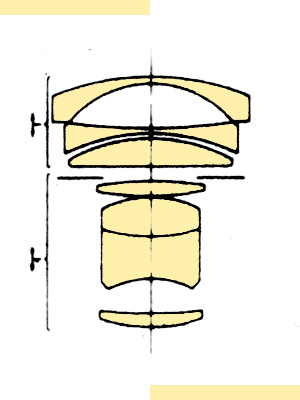The Mamiya Sekor E 3.4-4.5/35-70mm is a relatively small mid-range zoom lens for the Mamiya Z series SLRs. It was introduced around 1983, shortly before Mamiyas stopped producing 35mm SLRs as a result of the collapse of their Osawa distribution channel.
Unlike the Minolta 3.5/35-70mm which is similar in size and range, the Mamiya is a one-touch-zoom. Its optical construction - a typical two group zoom - is surprising minimalist: With only four lenses for the master lens and only three lenses for the front wide-angle converter is is a masterpiece of simplicity.
The Mamiya 3.5-4.5/35-70mm has a well made full-metal lens barrel. Minimal focusing distance (MFD) is 0.5 m over the entire range which is pretty good. There's no additional "macro" setting, and the aperture range is from f3.5 to f22 at f=35mm, and f4.5 to f32 at f=70mm. It's performance is average and does not equal the better 35-70mm lenses of the day (such as Minolta MD-III 3.5/35-70mm or Nikkor AIS 3.5/35-70mm).
Compared to the last (and best) version of the Minolta MD 3.5/35-70mm, the Mamiya zoom clearly shows some weaknesses.
At f=35mm and wide open, the inner 15mm of the image circle are very sharp and contrasty. Beyond that, and especially towards the corners, the image becomes mushy and outright unsharp. Stopping down to f5.6 doesn't change much, and only at f11 the image finally becomes comparable to that of the Minolta at f3.5 (!).
At f=50mm the performance of the Mamiya 35-70mm zoom is a lot better than at f=35mm. Apart from the corners, the image is clean and has a good detail resolution even at f4 (wide open). The corners have a low contrast and useable resolution which gradually increases when stopping down to f11. The Minolta, again, clearly has a higher corner resolution than the Mamiya, albeit at comparably low contrast wide open. At f5.6, even the extreme corners of the Minolta look excellent, and stopping down to f11 doesn't change anything.
At f=70mm the Mamiya again clearly is outperformed by the Minolta. Wide open at f4.5, the Mamyia zoom suffers from low resolution in the corners and low contrast at the borders, while the Minolta at f3.5 has a very good corner resolution and no lateral CAs, albeit at somehow reduced contrast. Stopped down to f8, most of the image of the Mamiya looks very good with high resolution and good contrast. The corners remain mushy, though - and to some extent even at f11. Some lateral CAs are visible. At f8 as well as at f11 the Minolta looks perfect over the entire frame, with no visible CAs.
The lens is somewhat rare, but available at relatively low prices (< CHF/EUR/ USD 50.--), often together with a Mamiya ZE or ZE-2 body.
 |
MAMIYA SEKOR E 35-70mm 1:3.5-4.5 (7 lenses / 6 elements)
|


